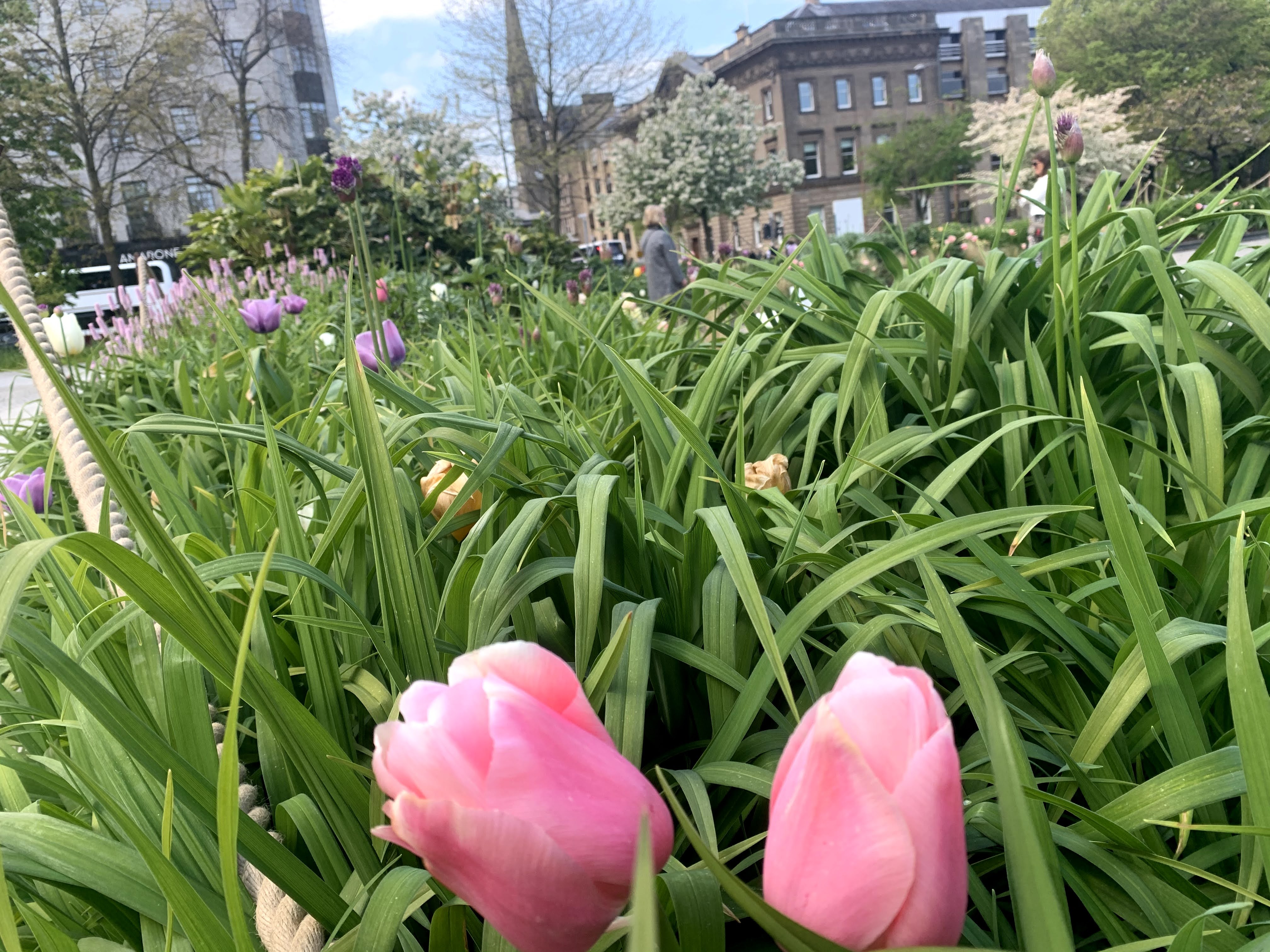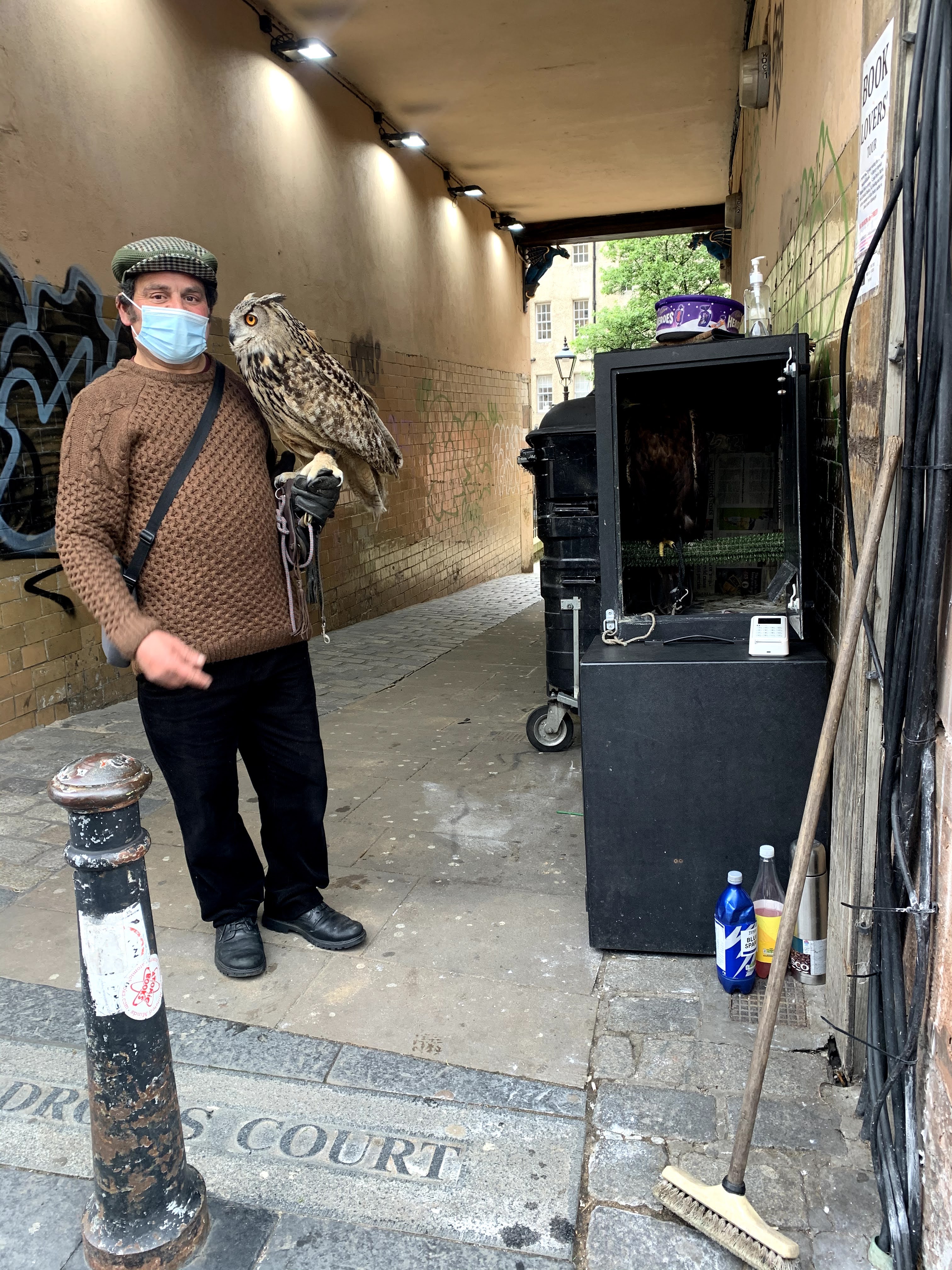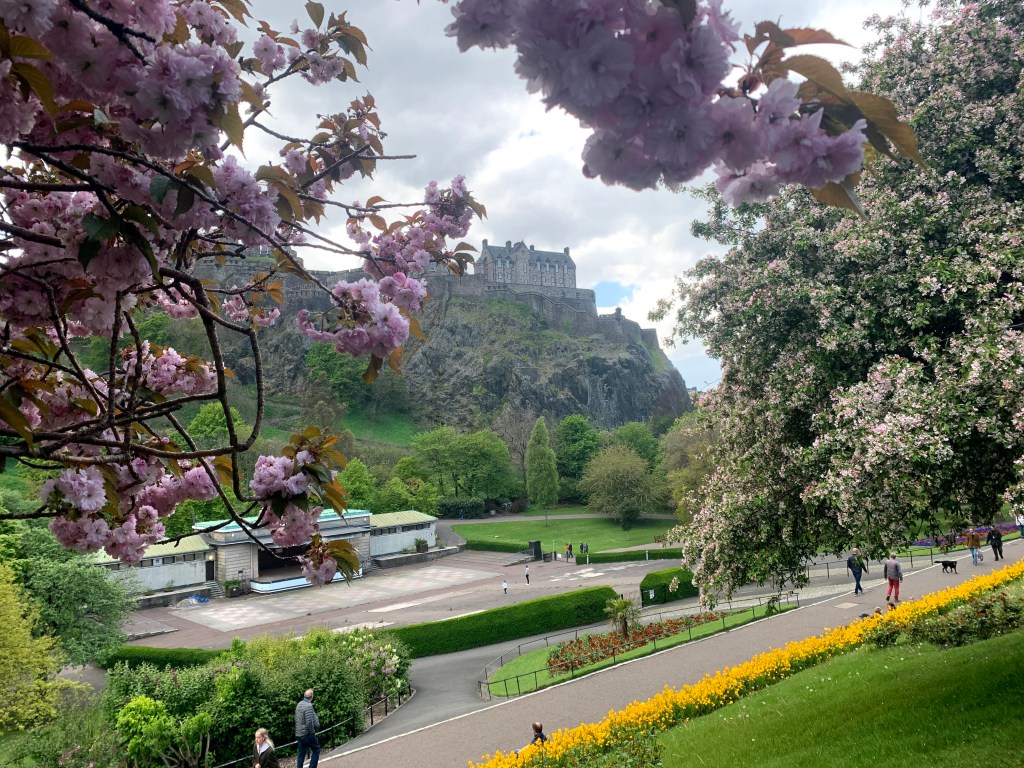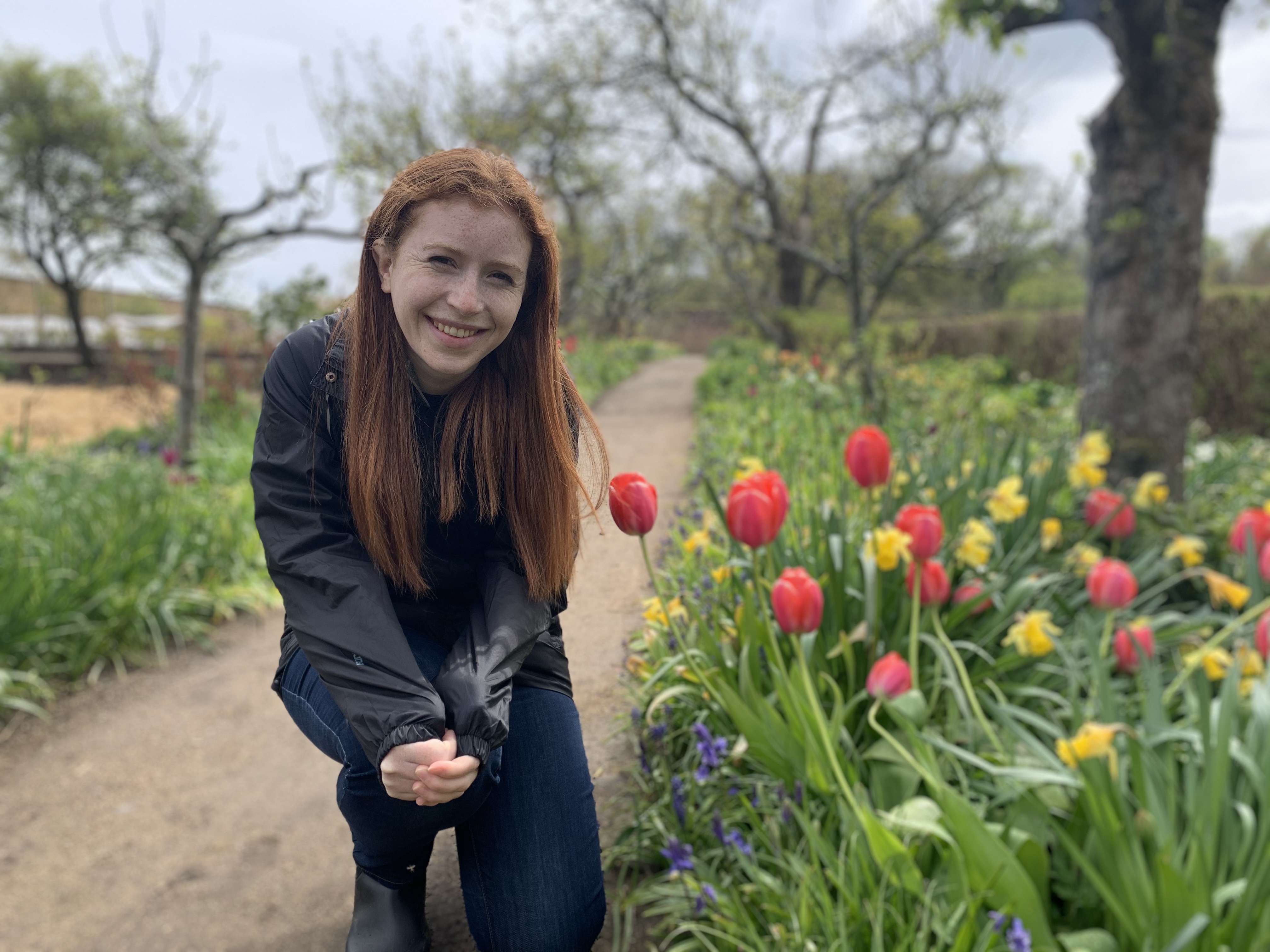



“Her name’s Hazel,” he said, gesturing to the huge owl perched on his left arm. She was the size of my torso, with enormous orange eyes in a face covered in light gray feathers. The rest of her feathers were black, white, and brown. Her pointy ears were turned back like a disgruntled cat’s. “Here, you can pet her with these.” He gave us feathers – I got a raven’s feather – and my friend, a couple of other tourists, and I used our feathers to stroke Hazel. She stared at me and blinked.
Edinburgh felt huge, fast, and busy after being in St. Andrews for nine months. The stone buildings, ornate scrollwork, Gothic spires, statues, and castles give it a medieval feel, but blinking traffic lights, blue and gray buses, and colorful storefronts mix in the neon of the twenty-first century. Pink cherry trees and tulips were in bloom in the city; yellow gorse made the surrounding hills glow.
Edinburgh Castle towers about the city like a dream in the sky.

It has been a stormy spring of cold rainfall, dark clouds, and winds that shake the blossoming trees. I’m not sure how I survived April’s pileup of assignments: an essay on Joy Davidman’s poetry and the theology of nostalgia; the relationship between faith, reason, and imagination in the works of Robert Kirk, James Hogg, and George MacDonald; a presentation on L.M. Montgomery and Dorothy L. Sayers’s contrasting perspectives on Christian doctrine; a class introduction for Part II of C.S. Lewis’s Till We Have Faces; an exam on T.S. Eliot’s Four Quartets, Shakespeare’s “A Winter’s Tale,” and Wagner’s “The Valkyrie.” I found cross-currents of beauty and wisdom in all of these works and my non-academic life:
- The joy of new life, pain of growing, and mystery of resurrection as represented by Spring
- The relationship between epistemology (the study of knowledge, or how you know what you know), truth, the natural world, and the supernatural
- Love as a way of knowing
- The paradox of surrender, grace, and continued effort in the life of faith
I have discovered that I am tireder, but more inspired and efficient, when I mingle fellowship and travel-adventures with study. Despite the weather, I have explored red sandstone clifftops and geos (sea inlets); the grounds of a castle surrounded by green woods full of white wild garlic; meadows of bluebells and cow parsley overlooking the harbor; a garden of purple-black, red, white, yellow, and pink tulips. Wandering through the hills and looking out over the sparkling ocean makes me feel like I’ve walked into a dream of paradise. Running through gray streets while trying to follow complex and contradictory GPS instructions to catch buses in the nick of time makes me feel like I’ve created my own nightmare. Travel is freeing, and wondrous, and so fun after months of lockdown, though I need to control my longing to go completely rogue as I still have a dissertation and part-time job to do.
This year has gone by so quickly. As I’ve said before, one Master’s degree does not even give you intermediate knowledge of a subject – just a cartographer’s view of your field of study, and not a detailed map, either. However, after two semesters of classes, I’ve discovered a few interesting things about Theology and the Arts and myself:
Academic vs. artistic thinking
I think my mind and skillset are better suited to a researching-artist’s life than an academic one. Academic thought requires absorbing an ocean of complex and diverse information (tons of books, articles, and lectures), meditating on it, and then synthesizing evidence to create a new perspective that will expand the field and spark new conversations. I can research and craft an argument, but my analysis tends to oversimplify and condense too much, ignoring the complexities of a subject. I still love learning, but I may be able to contribute better by creating stories than persuasive arguments.
The interrelation of doctrines and disciplines
In our “Christian Doctrine and the Arts,” course, our professor emphasized the unity of all the doctrines of Christianity. It’s difficult to speak about the doctrine of God the Father (patrology) without explaining His relationship with God the Son (Christology) and God the Spirit (pneumatology), but then you probably should define the Trinity, and the nature of the Trinity explains how salvation works (soteriology), and then you should explain how humanity fits in (Christian anthropology) and then perhaps how the Church matters in all of this (ecclesiology) and how all of time is rushing towards the final revelation (eschatology) . . . you get the idea. The creeds are unified, as the Trinity is unified, and the true Church is one.
I think disciplines of study are the same way. While it’s difficult to maintain both breadth and depth of knowledge, specializing in the humanities or the sciences means you neglect the wisdom of the other house. Interdisciplinary work is truly fascinating. One of our readings by Eleanore Stump, for example, drew on an analogy from math into theology by comparing the book of Job to a fractal (“The Story of Job: Suffering and the Second-Personal” in Wandering in Darkness: Narrative and the Problem of Suffering, pg. 220-21). Judith Wolfe, one of my professors, is working on a research grant now called “Mapping the Imagination” which combines psychology, philosophy, and phenomenology to examine how the imagination shapes what we perceive.
As a writer, I want to diversify my knowledge so that I can draw wisdom and analogies from many disciplines and create rich, complex, and fascinating worlds and stories. I will probably have to choose breadth of knowledge over depth.
The relationship between theology and the arts
In a previous post, I talked about the difficulty of defining the relationship between theology and the arts. In discussing religion and literature (I think this applies to the rest of the arts as well), John May describes a few perspectives: heteronomy (literature as the “handmaiden of faith”), autonomy (literature judged by its own norms), or theonomy (literature and religion both grounded in ultimate reality, God) (John May, New Image of Religious Film, 20).
My faith tradition is very Scripturally-focused: Plymouth Brethren/Baptist. I believe that the Word of God as a means of divine revelation comes first, before Church tradition, wordly ways of knowing, or personal experience. I am passionate about orthodoxy, or staying true to correct Spiritual teaching – hopefully in the truest sense, so that I am as fierce about living with grace, loving-kindness, and humility as I am about righteous behavior and beliefs.
For these reasons, my view is closer to heteronomy or “the arts as a handmaiden of theology,” demonstrating, exploring, discussing, or illustrating theological concepts, because I see theology or the study of God as the first thing, the pursuit that all other disciplines fall under. I see the arts as a means of glorifying God through human making, singing a “new song.” I don’t like overly simplistic, melodramatic, poorly-crafted artwork that tries to hammer morals into people’s heads by deception or manipulation. I love and want to create work that explores difficult questions, creates beauty, exposes ugliness, and seeks to love the artist’s audience through masterful craftsmanship and complex, thought-provoking techniques.
As an artist with academic interests, I have a new set of directions to explore as I work on my dissertation this summer and return home in the autumn, including protology (the study of Creation), ecclesiology (the study of the Church), mythopoeia (mythmaking art), and the folklore of Scotland and other parts of the world. This year’s coursework has given me enough to meditate on for a long, long time – but first, I have to finish it.
And, in the meantime, drink in all I can of Scotland as vaccines roll out and restrictions loosen: ruins dappled in golden afternoon light and shadow, hilltops shrouded in fog, sea caves echoing with the crash of waves, and cafes that serve interesting varieties of hot chocolate.




Alicia, I am absorbed by your lists of -doxy/-nomy/-logy names. I relate to being “tireder, but more inspired and efficient” when mingling or interweaving discipline with delight, freedom with limits, work and play. Thanks for the update and well wishes on your dissertation.
LikeLiked by 1 person
Thank you, Reagan! I know, all the diverse areas of theology open up worlds of wonder…though I have found that I really *need* art (like parables) to understand all the terms and systems and arguments. 🙂
LikeLiked by 1 person
Wow! There is so much to digest here. But I really like this post and I can especially relate to your section on “the relationship between theology and the arts.”
And to put it simply, I think “story” is king! Human beings crave story to help them understand life and to help them find meaning. My hopes and prayers for you is that you will support and create stories that lead people to the Truth!
LikeLiked by 1 person